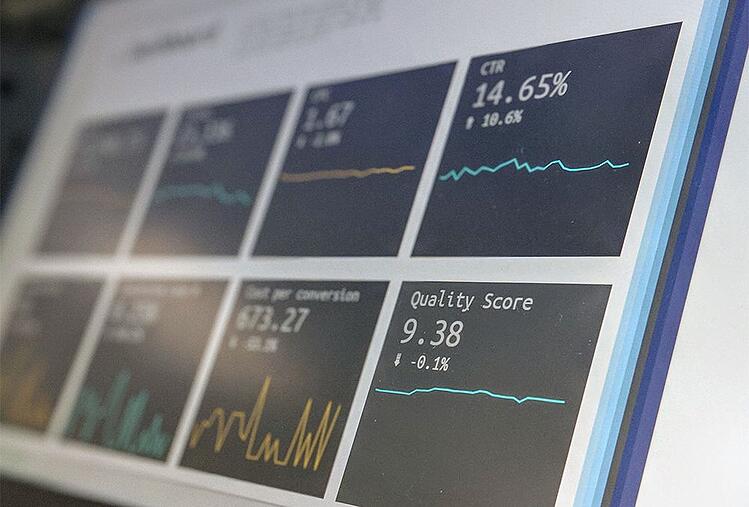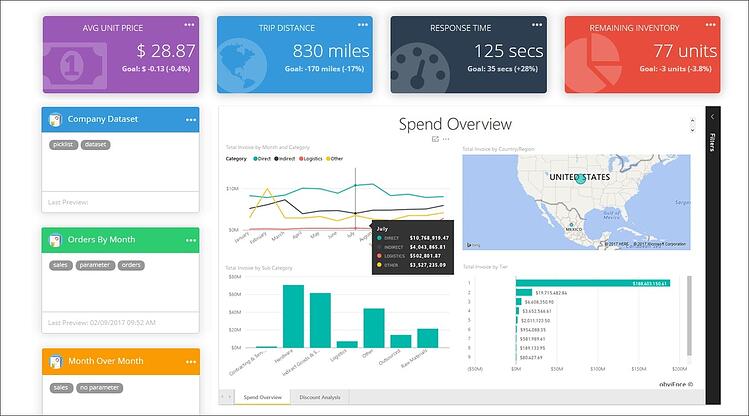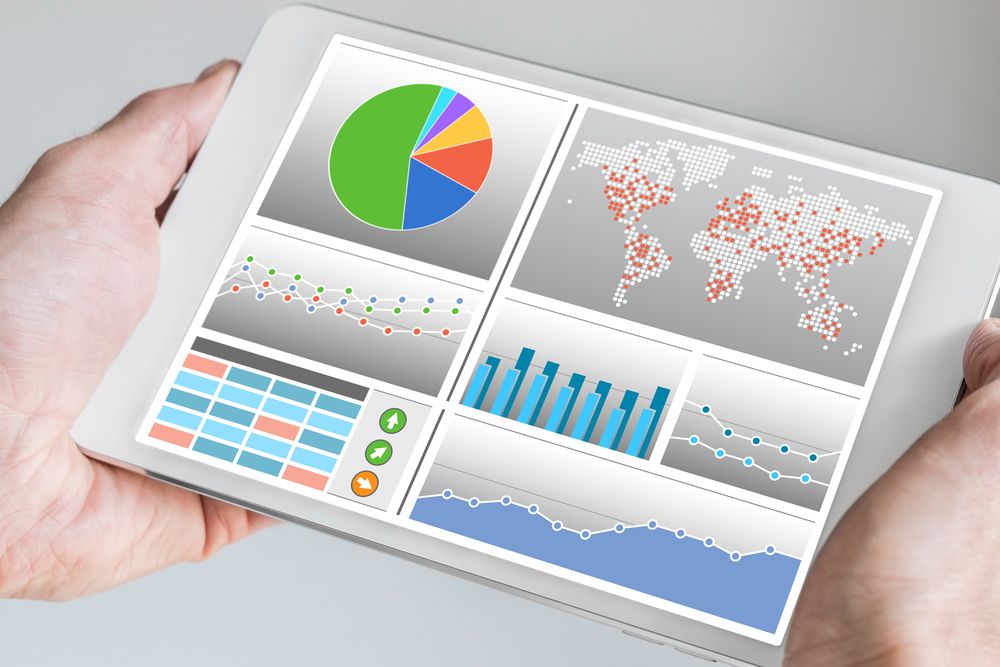Share this
Business Intelligence Dashboards
by Christian Ofori-Boateng on Jun 10, 2020 1:56:56 PM
Business intelligence dashboards are an incredible tool for any business to see progress in various areas of the business. Using data analytics software, you can develop a dashboard with key data points, KPI’s and metrics for your business all in one screen.
In this article, we’re going to discuss data analytics software, and the BI dashboard that they can produce.
Data Analytics Software
Data is the most abundant resource in any enterprise. It can come in various forms and from multiple sources. Therefore, it becomes quite complex to merge, relate, and analyze. Data analytics software can extract meaning from all your data for business gain or productivity. Additionally, these tools can be used to convert your business data into reports, dashboards, and other visualizations. It is worth taking your time to research and invest in proper data analytics software that can satisfy your business needs.
Various Kinds of Analysis

When you use data analytics software, you can enhance various functions within your organization. For instance, you can benefit from data analytics software by tracking user behavior and identifying poorly performing content. This will inherently enable you to enhance your product or service line and improve your bottom line as well. If you have different websites and mobile applications, you can use analytical software to collect information for optimizing your digital content as well.
Understanding Your Statistics
When you gather and visualize business data using effective data analytics software, it can reveal pain points as well as growth opportunities. Business intelligence ensures that you are not just making decisions based on instinct. Instead, you also are validating them by data and facts. The right business intelligence strategy can be game-changing for your company.
Where Can You Utilize Data Analytics?
Typically, executive management, operations, marketing, and sales teams are the main drivers of business intelligence in most organizations. They are also invested in creating advanced dashboards and visualizations. Since a variety of employees are utilizing data analytics software, its usability has become very important. Vendors are taking all precautions to ensure that their product quality, as well as usability, are top-notch.
Self-Service Tools are on the Rise
If you ask any business leader, he will confirm that self-service business intelligence creates a significant competitive advantage for them. Whether it is your finance, sales, or marketing department, self-service tools are creating a lot of value-added. Of course, your employees have to be smart enough not to duplicate work and to collaborate on the data gathering and data analysis.
To succeed in today’s marketplace, organizations must invest in useful data analytics software and empower users with interactive dashboards and reports. These tools tend to provide a lot of actionable insights into your business. Alerts and advanced data discovery can also enable smarter decisions, faster operations, and better overall performance.
Capabilities To Seek In Your Dashboard Software
Are you getting the most out of your data? A pivotal step to maximizing your data insights is finding dashboard software with the necessary features for your business. A dashboard is a graphic representation of your organization's data. Dashboards provide an easy way to monitor your business goals. Moreover, executives and employees can both benefit from a well-built dashboard. Overall, a successful dashboard offers the essential components for making informed decisions to drive business results.
Dashboard Filters

A typical dashboard in a large organization can combine multiple charts into one view. Since the dashboard may serve a large number of clients, it is a must that your dashboard software allows you to provide filters so that each user can customize the dashboard view. Filters, such as date range of your data or restricting data to a particular department, are examples of useful features to have.
Style Options
It would also be beneficial to have various style options to choose from when you are designing your dashboard. Your goal is to make your data tell a compelling and accurate story, and your dashboard layout and design can help you do that. Style options can include changing the font, color, or background color. Your dashboard software could also offer predefined themes that may work for your needs.
Various Chart Options
The more options you have in a visual representation of your data, the better your dashboard will be. A bar chart tells a different story than a line graph, so you should invest some time in choosing the right visual medium for your data representation on your dashboard.
Dashboard Access
You must provide 24/7 dashboard access to your users. The dashboard software that you select should offer you 24/7/365 access to your users from wherever they are. With the ever-changing economy and widely distributed clientele, dashboard software must enable easy access.
Dashboard Tabs
You should be careful while designing your dashboard to minimize clutter. A poorly-designed dashboard will contain too many unrelated visualizations. If you happen to have unrelated visualizations, they should be clubbed under different tabs to not confuse the user.
When you are in the market to choose dashboard software, make sure to do your research. You must select software that meets your needs and helps you design a comprehensive, accessible, and insightful business dashboard.
Characteristics of A Real-Time Dashboard
A real-time dashboard is a dashboard that shows the data as it is changing in real time. It is entirely different than a standard management dashboard. A real-time dashboard helps with immediate decision-making. When designed carefully, a real-time dashboard can be quite useful for your business operations.
Characteristics of a Real-Time Dashboard

Since it helps with immediate decision-making, the information displayed on a real-time dashboard must be easy to interpret. It should also have the ability to alert users to problems and help with next steps. Depending on the design of your real-time dashboard, it could have a summary metrics page as well as detailed data. The summary statistics will indicate the high-level picture and help users tell at a single glance what is going on. But the detailed page can provide more insights for decision-making.
How to Design a Real-Time Dashboard
The first step is to figure out the purpose of your dashboard and all the elements that make up the metrics that are being displayed on it. You should have a comprehensive knowledge of how these elements relate to each other and the overall architecture of those elements. From a design perspective, it is imperative that a real-time dashboard provides a quick diagnosis of the problem. Users should be able to point to the source of the problem using your dashboard.
Simplicity is Critical
Since real-time dashboards enable quick decision-making, they need to have a simple data presentation that doesn't take long to decipher. A number of time data scientists are so fascinated by data elements that they forget to design the dashboard for average users who don't need to look “under the hood.”
Choose an Appropriate Time Window
When you design your real-time dashboard, you need to figure out the optimal time window so that the metrics and trends don’t represent too long a time window. Similarly, don’t choose too short a time window because then the data will not be meaningful enough. You can even design it so the time window can be scaled up or down as needed. A flexible design is always preferable and will last longer.
Real-time dashboards can be helpful in many ways in your organization. They can drive behavior, critical thinking, and robust decision-making. When you are designing one, keep in mind all the factors and carefully design it for widespread usage.
Design Elements of A Business Intelligence Dashboard
It’s not always easy to design an excellent and functional dashboard. You can't just drop a few charts onto a dashboard and expect it to do wonders for your business. Proper dashboard design requires thought-through placement and intricate knowledge of your data.
Knowing Your Data
First and foremost, you should be familiar with the data you are working with. How will you go about collecting the data and how often? One of the most common mistakes business analysts make is choosing the wrong medium to display their data. You don't need to get overly fancy with the displays unless it is a custom requirement. Sometimes simple bars and graphs will do the job perfectly. Overly complicated graphics may confuse the users and may require more explanation.
Placement of Your Dashboard
When designing your business intelligence dashboard, you need to consider a few elements for placement. You start off with determining what you want in your dashboard. You can't display everything, so you need to focus on important metrics and KPIs that will help in decision-making. You don’t want to make the mistake of overloading the dashboard with too many metrics and data. It will complicate the design and dilute the messaging. After designing your business intelligence dashboard, you can test with a focus group for usability and decide if you want to make any tweaks based on their feedback.
How’s The Speed?
Another critical aspect of a business intelligence dashboard is the speed with which it loads your data. You need to keep that in mind while designing so that you don’t overload it and compromise the speed. It would be disastrous if you are trying to load your business intelligence dashboard in an all-hands meeting, and it takes several minutes to load.
Color Scheme
The color scheme of your business intelligence dashboard is also quite important. You can experiment with a few different palettes and also gather feedback from a focus group or beta testing before finalizing on your color scheme.
It would be wise to take your time in designing your dashboard so that it can serve the purpose for all your clientele and helps you make better business decisions. Choose software that fulfills all your needs and helps you build a purposeful dashboard.
How To Tell The Difference Between A Scorecard And A Dashboard
A real-time dashboard is an essential part of BI software today. What about scorecards, though? You may know all about dashboards, but do you know how scorecards work? While they sound like they perform the same task, they’re actually quite different to each other. You need both for your company to function efficiently, but you have to use them to their strengths. Learn how to tell the difference between a scorecard and a dashboard.

What are They Used for
This is the first difference between KPI scorecards and dashboards. You use dashboards to measure the performance of your company. This is either by evaluating the performance metrics of your individual departments or the company as a whole. Dashboards help you and your managers monitor your company as it goes through daily operations. Scorecards, on the other hand, are meant to manage the overall progress of your company towards its goals. It isn’t meant to monitor daily objectives, but to measure how well the company is doing in the grand scheme of things.
The Type of Measurement Used is Different
As the name KPI scorecards may already have told you, scorecards use KPIs to measure progress. You define a target for your company, whether a certain sales volume or turnover rate. The metrics for that same factor are measured by your dashboard and used by the scorecard to compare the result to your target. Your dashboard simply measures company performance. Scorecards compare this performance to the targets you set for the company. In a dashboard, this measurement isn’t related to your business’ goals.
When Are They Updated
When you think about your Business Intelligence dashboard, what words would you use to describe it? Most people would go with “real-time”. Dashboards exist to give you better operational control. Using the data collected and presented in them, you can make better decisions for your company. This can boost your company’s profitability in time. A scorecard is different because it measures long-term progress. The updates to the information on your scorecard don’t happen until a certain period of time has passed. This is usually a month, although it can vary based on how your company measures success.
What Does Each Focus On
There are two types of goals a company can have. Some call this the vision and the mission. Others call them objectives and goals. The most common term in the business world is “operational” and “strategic” goals. A business dashboard focuses on measuring and achieving the operational goals of your company. These are the short-term objectives you have for it. Scorecards help you push your business towards its strategic goals or the long-term goals you want to achieve.
How Can You Use Each
Real-time dashboards are used way more often than KPI scorecards because of their short-term usage. You use dashboards every day to get information about your company and what is happening in it. With your level of access to your BI software, you can view the statistics and measurements of your company at a high level. With a scorecard, you gain the ability to use measured data to identify problems in your company’s processes. You can use this data to work towards a solution to the problems your business faces.
Both dashboards and scorecards must be used together in the industry today. If you want to get an idea of both your long and short-term goals as well as varied types of measurements, you need both. Scorecards measure your long-term goals and compare them to your KPIs. They update periodically and give you strategic advantages. Dashboards focus on short-term work and present raw, real-time data. Both are crucial to your company’s success.
What are Intuitive Business Intelligence Dashboards?
With the boom of the business intelligence industry in tandem with the rise of big data, catchy terms and keywords are everywhere. Without previous knowledge, most are indecipherable. Understanding exactly what a BI dashboard is and how it has revolutionized the industry is tricky enough. Figuring out what developers mean by terms like ‘intuitive’ is even more confusing. Despite the word’s implications, even the best BI dashboards cannot generate decisions based on what they believe to be true. It’s actually the users who use their instincts to master intuitive business intelligence dashboards.

BI Dashboards
Dashboards in business intelligence provide a direct, central access point for all the data handled by the system. Most dashboards come with various features, including live tallies, charts, links, and other useful options. Typically, the software developer provides these options, but most dashboards are at least partially customizable. This allows users to gather important, related data onto a single screen. BI dashboards are similar to control panels, but rather than using them to manipulate the system, the system uses the dashboards to communicate actionable information.
Ease of Training
The difference between a dashboard and an intuitive dashboard is all about how naturally the layout feels to users. This begins with training. The more awkward and complex the system is, the less intuitive it is, and the longer it takes to understand. New users have to work hard to understand exactly how the system works.
An intuitive system is easy to understand. The layout follows the natural path of the eye, allowing users to quickly identify critical features. It should follow expected software patterns, making it simple for a new user to find things like the menu, almost instinctively. The less a new user needs to study a dashboard in order to make use of it, the more intuitive it is. In the world of BI dashboards, this means that even customizable options should fit on the screen in a way that feels natural. Different features should be clearly identifiable, and users should be able to use them quickly and easily with minimal training.
Ease of Use
Intuitive dashboards should continue to be easy to use throughout their lifetimes. For example, when a user needs to change something on a BI dashboard, a simple, easy process is best. The user shouldn’t need much if any, further information in order to perform advanced functions. If the dashboard’s ease of use is limited to its initial form and features, then it isn’t very intuitive. Ideally, a BI dashboard features the flexibility and range to remain useful over time, and that demands easy changes and simple modifications.
From the very beginning, intuitive Business Intelligence dashboards need to emphasize ease of use. Even if a user has never used a dashboard-based system before, they should quickly and easily understand all relevant features. The system should maintain this standard throughout its time in use. When users need to make changes, they should not have to struggle. Dashboards’ value is in their data, after all, and a dashboard that makes accessing that data difficult is a flawed tool. This is why the best BI dashboards are always intuitive.
Share this
- Business Intelligence (179)
- PBRS (176)
- Power BI (158)
- Power BI Reports (156)
- Power BI Reports Scheduler (151)
- IntelliFront BI (118)
- Microsoft Power BI (103)
- Business Intelligence Tools (81)
- Dashboards (81)
- Data Analytics (81)
- Data Analytics Software (80)
- Data Analytics Tools (79)
- Reports (79)
- KPI (78)
- Crystal Reports (36)
- Crystal Reports Scheduler (35)
- SSRS (33)
- SSRS Reports (25)
- SSRS Reports Scheduler (25)
- CRD (24)
- SSRS Reports Automation (23)
- Tableau (15)
- Tableau Report Automation (13)
- Tableau Report Export (13)
- Tableau Report Scheduler (12)
- ATRS (9)
- Crystal Reports Server (9)
- Tutorial (8)
- Tableau report (7)
- Automated Tableau Workflows (6)
- Power BI to CSV (6)
- Power BI to Excel (6)
- Crystal Reports automation (5)
- Power BI Report Scheduler (5)
- business reporting portal (5)
- Power BI Dashboards (4)
- Tableau scheduled reports (4)
- ATRS Release (3)
- Business Analytics (3)
- ChristianSteven (3)
- KPI software (3)
- KPIs (3)
- Power BI report automation (3)
- Reporting (3)
- Schedule Tableau reports (3)
- Tableau Automation Tools (3)
- Tableau user permissions (3)
- business intelligence for finance department (3)
- business intelligence reports (3)
- Best Tableau charts (2)
- Bi dashboard (2)
- CRD software (2)
- Data-driven scheduling (2)
- PBRS Release (2)
- Report automation (2)
- Self-Service Data Analytics Tools (2)
- TSC API Integration (2)
- Tabcmd Scripting (2)
- Tableau charts (2)
- Tableau financial reporting (2)
- best tableau dashboards (2)
- bi dashboard solution (2)
- business intelligence software (2)
- crystal reports software (2)
- data analytics solutions (2)
- key performance indicators (2)
- power bi email subscriptions (2)
- power bi refresh (2)
- share power bi reports (2)
- tableau dashboards (2)
- tableau extensions (2)
- tools for business intelligence (2)
- Automated report delivery (1)
- Automated reporting trigger (1)
- BI, data exploration (1)
- CRD automation features (1)
- Conditional report distribution (1)
- Conditional report generation (1)
- Data Driven Schedules (1)
- Data Visualization Skills (1)
- Dynamic Power BI reports (1)
- Dynamic report generation (1)
- Free Tableau License (1)
- GH1 (1)
- Power BI scheduling tools (1)
- Scheduled report distribution (1)
- Static Power BI Report (1)
- Tableau Public Projects (1)
- Tableau access levels (1)
- Tableau financial dashboard (1)
- Tableau for Students (1)
- Tableau for finance (1)
- Tableau guide (1)
- Tableau images (1)
- Tableau permissions (1)
- Tableau server multi-factor authentication (1)
- Types of Tableau charts (1)
- ad-hoc reporting (1)
- automated distribution (1)
- automation in power bi (1)
- batch reporting (1)
- benefits of automation in power BI (1)
- bi data (1)
- bi roi (1)
- business intelligence implementation challenges (1)
- construct bi reports with power bi (1)
- construction bi (1)
- creating tableau dashboards (1)
- crysyal reports distribution (1)
- dashboard software (1)
- data analytics business intelligence difference (1)
- data analytics product (1)
- data analytics techniques (1)
- distribute power bi report (1)
- email power bi (1)
- enterprise bi server (1)
- enterprise bi software (1)
- export tableau to Excel (1)
- hospital business intelligence (1)
- how to save tableau workbook (1)
- images in Tableau (1)
- incisive analytics (1)
- intuitive business intelligence (1)
- on-prem BI report (1)
- power BI exporting (1)
- power bi emails to share reports (1)
- power bi for construction project (1)
- power bi gateway (1)
- power bi healthcare (1)
- print power bi report (1)
- real estate business intelligence (1)
- retail BI report (1)
- retail KPI (1)
- save tableau workbook with data (1)
- schedule power bi (1)
- schedule power bi reports (1)
- scheduled power bi emails (1)
- scheduled reports (1)
- scheduling Power BI reports (1)
- share power BI reports by email (1)
- share your Power BI reports as PDF (1)
- stories in tableau (1)
- tableau add-ons (1)
- tableau data export (1)
- tableau for Excel (1)
- tableau mobile (1)
- tableau mobile app (1)
- tableau multi-factor authentication (1)
- tableau plugin (1)
- tableau software (1)
- tableau story (1)
- tableau story example (1)
- tableau storytelling (1)
- tableau workbook (1)
- tableau workbooks (1)
- use drop box to share Power BI Reports (1)
- user-friendly analytics (1)
- what is Tableau (1)
- what is Tableau software used for (1)
- December 2025 (1)
- November 2025 (4)
- October 2025 (5)
- August 2025 (5)
- July 2025 (5)
- June 2025 (4)
- May 2025 (5)
- April 2025 (2)
- March 2025 (6)
- February 2025 (4)
- January 2025 (1)
- October 2024 (1)
- September 2024 (1)
- April 2024 (1)
- March 2024 (1)
- February 2024 (1)
- January 2024 (1)
- December 2023 (1)
- November 2023 (1)
- October 2023 (2)
- September 2023 (1)
- August 2023 (1)
- July 2023 (1)
- June 2023 (1)
- May 2023 (1)
- April 2023 (1)
- March 2023 (1)
- February 2023 (1)
- January 2023 (1)
- December 2022 (1)
- November 2022 (1)
- October 2022 (1)
- September 2022 (1)
- August 2022 (1)
- July 2022 (1)
- June 2022 (1)
- May 2022 (1)
- April 2022 (1)
- March 2022 (1)
- February 2022 (1)
- January 2022 (1)
- December 2021 (1)
- November 2021 (1)
- October 2021 (2)
- September 2021 (1)
- August 2021 (2)
- July 2021 (1)
- June 2021 (4)
- May 2021 (5)
- April 2021 (3)
- March 2021 (2)
- February 2021 (2)
- January 2021 (2)
- December 2020 (2)
- November 2020 (2)
- September 2020 (8)
- August 2020 (3)
- July 2020 (5)
- June 2020 (11)
- May 2020 (2)
- April 2020 (3)
- March 2020 (2)
- February 2020 (5)
- January 2020 (7)
- December 2019 (9)
- November 2019 (9)
- October 2019 (10)
- September 2019 (5)
- August 2019 (6)
- July 2019 (13)
- June 2019 (8)
- May 2019 (3)
- April 2019 (5)
- March 2019 (4)
- February 2019 (3)
- January 2019 (10)
- December 2018 (2)
- November 2018 (22)
- October 2018 (10)
- September 2018 (12)
- August 2018 (5)
- July 2018 (23)
- June 2018 (29)
- May 2018 (25)
- April 2018 (12)
- March 2018 (22)
- February 2018 (15)
- January 2018 (15)
- December 2017 (6)
- November 2017 (4)
- October 2017 (4)
- September 2017 (4)
- August 2017 (4)
- July 2017 (7)
- June 2017 (12)
- May 2017 (10)
- April 2017 (6)
- March 2017 (10)
- February 2017 (7)
- January 2017 (5)

No Comments Yet
Let us know what you think